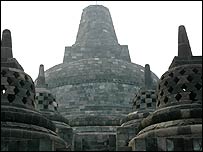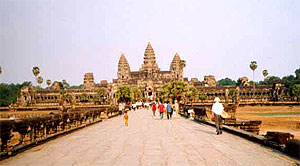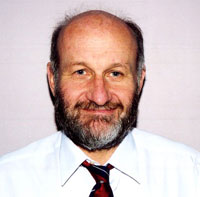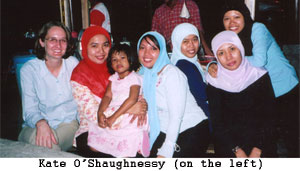Analysis
 |
PRESERVING SOUTHEAST ASIA'S ARCHITECTURAL HERITAGEby Professor Ken Taylor, Visiting Fellow, Research School of Humanities, Australian National University |
|
Southeast Asia is experiencing a rapid increase in the number of tourists, domestic and foreign, visiting heritage places and sites. The result is all too often damage to archaeological sites and historic places like temples, traditional villages and historic towns. This is not merely because of the sheer numbers of people involved, but also because of the impact of the vehicles and buses used to transport the visitors. A familiar sight at many places is lines of motorised vehicles dropping and collecting tourists right on the doorstep of historically significant places, not unlike a mini football match crowd.
The vehicles bring pollution from fumes and dust which
drifts onto buildings and into interiors. The tramp of feet wears away
stones steps and paving: at Borobudur near Yogyakarta it is reckoned
that the effect of 2 million visitors each year walking up the main
staircase is to wear away 2mm of stone per year. At Angkor the sandy
soil at some archaeological sites has been covered by sand-filled plastic
bags to try to ameliorate wear and tear by pedestrians; in other places
timber walkways have been erected. Neither of these solutions, particularly
the first, is visually satisfactory. |
People touch wall carvings, depositing weak acid from sweaty hands that slowly but surely damages the stone; they climb over and on brick, stone and stucco remains abrading bits and pieces, not to mention causing danger to themselves. You will see tourists at Angkor Wat happily climbing one of the steep staircases for the thrill of seeing the view, then facing the descent with horror. Watching people struggle down in tight miniskirts, high heels or thongs is a frightening sight. A fatal accident, as has already happened at Bagan in Myanmar, cannot be far away. Even more sombre is the way local communities, traditions, and knowledge systems are ignored in the rush to market cultural heritage. This effect is multiplied when places are added to the World Heritage list and hence become more lucrative targets for tourism. Silpakorn University, Bangkok, through its International Program in Architectural Heritage Management and Tourism MA and PhD programs (which started in 2002) recognises the need for professionals educated in heritage conservation and tourism. |
The program sets out to equip students with a common understanding of appropriate concepts of tourism and heritage conservation. It prepares those who will be professionally involved in the two fields to assess and reassess their actions and set directions for management and protection of heritage resources. Critical to the process is the concept of understanding cultural heritage significance. Working closely with Thai colleagues, a number of Australian academics helped to set up the program at Silpakorn in the period leading to 2002, through discussions on syllabus material and course objectives. Now they teach in tandem with Thai academics and act as supervisors for doctoral students. They include staff from the Cultural Heritage Centre for Asia and the Pacific at Deakin University headed by Professor William Logan, and the author of this article (Professor Ken Taylor). Bringing together this expertise provides an international
perspective and develops an understanding of the universal aims of heritage
management. Notably, it offers Australian staff an opportunity to gain
an understanding and appreciation of Asian attitudes, local and regional
needs and cultural context. Links:
|

 |
WOMEN IN POLITICS IN ASIAby Francesca Beddie, Editor, Asian Currents |
|
Amid the debate on uranium and shaping industrial relations policy, a fringe event at the recent Australian Labor Party (ALP) conference received little attention. It was a forum on the empowerment of women in the legislatures of Asia, where representatives of a new generation of Indonesian and Filipino politicians highlighted the challenges they face in bringing women into the political process. The forum resulted from a little advertised program funded by the Australian Government’s Department of Finance and Administration. The Australian Political Parties for Democracy Programme, from which both the Liberal and Labor parties have received grants, is designed to assist in the promotion of strong democracies in Asia and the Pacific. Part of the ALP’s effort has been to work with the United States National Democratic Institute (NDI) to strengthen women political leaders in Southeast Asia. Andi Yuliani Paris, a member of the Indonesian People’s House of Representatives (DPR) for the Partai Amanat Nasional (National Mandate Party, formed by Amien Rais), stressed the importance of educating the élite of Indonesia’s political parties about the role women can play in building democracy. It was not enough to establish a quota (30 per cent) for female party membership. Women must also be placed high enough on the ticket to have a real chance of being elected. Her point was reinforced by another speaker, Stephanie Lynn, the director of the Political Party and Women’s Participation Programs (NDI Southeast Asia). Lynn pointed out that when voters, rather than parties, had a direct choice they preferred female candidates. This had been the case in the elections to the Indonesian upper house, where voting is based on individuals not on party lists. |
In the lower house (DPR), there were many more female candidates, but fewer were elected because of their low position on the ballot paper. Andi Yuliani speculated that the way to achieve affirmative action in favour of women was to offer financial incentives. Her suggestion that parties receive a bonus for each woman elected to parliament was greeted with applause from the audience!
That is why she is also part of the 'Women's Party-list' group, Abanse! Pinay, which seeks to advance the women's agenda in Congress, an agenda it argues embraces all aspects of social change, including agrarian reform and rural development, environmental protection, peace and good governance. This caucus was formed out of training from NDI and through subsequent networking. |
The group supported 8 candidates in the May elections as well as providing voter education and developing local training manuals. (Final results from the election were not available at the time of publication: see Philippines Commission on Election: http://www.comelec.gov.ph for updates.) Links:
|

Profile
|
This month we profile Professor Graeme Hugo,
http://www.arts.adelaide.edu.au/socialsciences/people/ges/ghugo.html
Federation Fellow, Professor of the Discipline of Geographical and Environmental
Studies and Director of the National Centre for Social Applications
of Geographical Information Systems at the University of Adelaide. Professor
Hugo is the 2008 Chair of the Social Sciences and Politics Panel for
Research Quality Framework http://www.dest.gov.au/sectors/research_sector/policies_issues_reviews/key_issues/research_quality_framework |
||
|
Q: What are your current preoccupations?
|
I believe that this is the case but that in the contemporary migration regime these benefits are being blocked. The reasons for this are many – bigotry, racism, a lack of bilateral and multilateral consultation about migration and scapegoating by media and politicians and others. Increasing cooperation between countries on migration issues is crucial if the full benefits of migration are to be realised. Q: How do these fit into the contemporary scene? Q: What are your hopes for Asian studies in
Australia? Links:
|
|

Student of the month
|
|
Australia, travelling throughout Malaysia with one of her new friends. This revealed a fascinating world she had never considered, and one right at Australia’s doorstep. After graduating (majoring in Australian history), Kate worked for two years as an assistant-curator in the History Department at the Western Australia Museum before taking part in the ACICIS exchange program, in Yogyakarta, Indonesia, in 2000. She stayed in Yogyakarta for eight months, an incredibly rewarding experience which was just long enough to learn that there was much more to learn about Indonesia. After a few more years of work and travel, in 2003 she commenced a PhD in history at the University of Western Australia, exploring the regulation of marriage and divorce during and after the rule of the New Order, which was submitted at the end of 2006. When Kate started looking for employment last year, she found that some knowledge of Islam, Indonesian culture and language were extremely useful, something she’d never planned on. In February of this year, she took up a position as a Graduate Trainee at the Department of Foreign Affairs and Trade, and is looking forward to learning more about Asia in her future work. |

Website of the month
| UNICEF’s 2007 report on the State of the World’s Children starts by examining the status of women (chapter 1), then discusses equality in the household, in employment and in politics and government (chapters 2-4) before outlining how to accelerate progress and thus produce the double dividend of gender equality and improved welfare for children (chapter 5). The five chapters are available in separate PDFs. The website also features video and multimedia material. |
Recent article of interest
|
Strange Flowers on the Diplomatic Vine, US Detainees in Cambodia,
1965-1970 by Neil Manton tells how the Australian Embassy in Phnom
Penh became responsible for the welfare of 23 US servicemen shot down
or arrested in Cambodia and how these men were released and repatriated.
The book is available from the author: manton@cyberone.com.au |

Did you know?
| The Federal Budget did not address the issue of declining language students. Fewer than 6,000 students, out of nearly one million at Australian universities, are studying Chinese and nearly half of these students are from Asia. The number of those studying Indonesian has declined be 25 per cent between 2001 and 2005 while enrolments in Japanese fell by more than 5 per cent. (Reported in the Australian Financial Review, 30 April 2007.) This has profound implications for Australia’s competitiveness in a globalising world, where English as a sole language is in decline, with the vast majority of English speakers being bilingual or multilingual. For an historical point of view, see Deborah Henderson’s analysis of Australia’s 1990s’ National Asian Languages and Studies in Australian Schools (NALSAS) Strategy in the Electronic Journal of Foreign Language Teaching, co-published by the ASAA and the Centre for Language Studies at the National University of Sydney: http://e-flt.nus.edu.sg/ |

Diary dates
|
THRESHOLDS OF TOLERANCE, 10 May to 5 June, Canberra. This exhibition explores the theme of art as the conscience of humanity. It includes artist from Australia, Indonesia, East Timor and Thailand and is linked to national conference ‘Art and Re-enactment’ hosted by the Australian National University’s Research School of Humanities from 5-7 June. ANU School of Art Gallery, corner of Ellery Crescent and Liversidge Street, Acton; Tuesday to Friday 10.30am to 5pm; Saturday, noon to 5pm. See also http://www.anu.edu.au/hrc/conferences/conferences_2007 VESAK FESTIVAL - A Sri Lankan Experience, 26 May, Brisbane. The program includes: a traditional Sri Lankan parade, display of beautiful Vesak Lanterns and performances of traditional and ceremonial songs and dances. Organised by the Buddhist Vihara Temple of Queensland, supported by Brisbane City Council and Brisbane Multicultural Arts Centre. Free event with Sri Lankan food for sale. TIME: 7pm.
CHINESE STUDIES ASSOCIATION OF AUSTRALIA, 10th Biennial Conference, 27-29 June 2007, Brisbane. Griffith University will be hosting the conference at Southbank in Brisbane. Watch the website for details: http://www.csaa.org.au/news.html THE 2ND ASIAN AUSTRALIAN IDENTITIES CONFERENCE,
28-30 June, Melbourne. The "AAI 2" conference focuses
on the significant momentum of Asian Australian Studies since the inaugural
1999 conference. Invited speakers include filmmakers, academics, politicians,
artists and writers. To register, please visit http://www.asianaustralianstudies.org/ CHINA: EAST ASIA MEDIA/NEW MEDIA CONFERENCE, 5-6 July, Brisbane. With the Beijing Olympics moving closer China is mounting a claim for a leading role in the global and regional cultural economy, drawing on its long tradition as the centre of East Asian culture. Will this be vision ever be achieved? The conference will be hosted by the Australian Research Council Centre of Excellence for Creative Industries and Innovation http://www.cci.edu.au AUSTRALIAN SOCIETY OF INDONESIAN LANGUAGE EDUCATORS (ASILE) Conference, 5-8 July, Caloundra. The 9th ASILE conference at the University of the Sunshine Coast will provide opportunities for Indonesian educators and students to network with one another and hear the latest news on education developments in Australia. Rydges Oasis Resort, Caloundra. See http://intranet.usc.edu.au/wacana/ASILE/index.html IN SEARCH OF RECONCILIATION AND PEACE IN INDONESIA, workshop 19 and 20 July 2007, Singapore. The Indonesia Study Group, Asia Research Institute, National University of Singapore is holding an interdisciplinary workshop to examine approaches to reconciliation and peace in Indonesia. >>> |
Its aim is to provide insights into ways forward not only for Indonesia, but for conflict situations much more broadly. http://www.ari.nus.edu.sg or contact the convenor, Dr Birgit Bräuchler aribb@nus.edu.sg APEC ECONOMIC LEADERS MEETING, 8-9 September, Sydney. The main event of the APEC year brings together the 21 APEC Member Economy leaders, thousands of delegates, support personnel and the international media. See http://www.apec2007.org CHINA: CONFERENCE ON MIGRATION AND SOCIAL PROTECTION,
25 to 26 September, Beijing. Monash University's Asian Business
and Economics Research Unit together with the Institute of Population
and Labour Economics at the Chinese Academy of Social Sciences and the
Renmin-Monash Advanced Centre for Economic Studies are staging an international
conference to explore issues such as: labour market integration and
social protection, migrant participation in social security schemes,
migrant alternatives to state-sponsored social protection, migrant working
conditions, salaries and wage arrears, and responsibilities of government
in the provision of social protection. See ASPIRE: WATER AND SANITATION IN THE ASIA-PACIFIC
REGION: Opportunities, Challenges and Technology, Perth, 28 October
- 1 November 2007. The Australian Water Association, in conjunction
with the International Water Association is organising this conference,
which will focus on design, operation, maintenance and management of
water and wastewater systems. Innovations in the field, case studies
on safe and reliable systems for removal of nutrients, water reuse,
and methods of better operation will also be discussed at the conference.
There will be specific emphasis on issues facing the Asia-Pacific Region.
Perth Convention & Exhibition Centre. See http://www.awa.asn.au/AM/Template.cfm?Section=ASPIRE_2007 ASIA PACIFIC REGION: SOCIETIES IN TRANSFORMATION
conference, Georgetown (Penang) Malaysia, 19-22 November, 2007. The
region is seemingly now more integrated, with unprecedented levels of
tourism, migration, and economic and cultural linkages. But, are the
nations of the region, and their populations, more divided, united or
are they fundamentally unchanged over the past two decades? These are
questions to be raised in a conference co-sponsored by the School of
Social Sciences, Universiti Sains Malaysia (USM) and the Centre for
Asia Pacific Social Transformation Studies (CAPSTRANS), University of
Wollongong, Australia The conference website link is at: 17th NEW ZEALAND ASIAN STUDIES SOCIETY (NZASIA) CONFERENCE, Otago, 22-25 November 2007. This will be an open, multidisciplinary conference. Participants are invited to submit panel or paper proposals presenting original research on any Asian-related topic. Proposals for panels are welcome. Paper abstracts, single-spaced and no longer than 200 words, must be submitted before 1 June 2007 to nzasia.conference@stonebow.otago.ac.nz Full conference details can be found at http://www.nzasia.org.nz |

You are welcome to advertise Asia-related events in this space. Send details to: fbeddie@ozemail.com.au
Feedback
What would be useful for you? Human interest stories, profiles of successful graduates of Asian studies, more news about what's on, moderated discussions on topical issues? Send your ideas to fbeddie@ozemail.com.au.
About the ASAA
The Asian Studies Association of Australia (ASAA) promotes
the study of Asian languages, societies, cultures, and politics in Australia,
supports teaching and research in Asian studies and works towards an understanding
of Asia in the community at large. It publishes the Asian Studies Review
journal and holds a biennial conference. ASAA and the Centre for Language
Studies at National University of Singapore also co-publish an annual supplementary
issue of the Centre's fully peer-reviewed electronic Foreign Language Teaching
Journal (e-FLT). See http://e-flt.nus.edu.sg
The ASAA believes there is an urgent need to develop a strategy to preserve,
renew and extend Australian expertise about Asia. It has called on the government
to show national leadership in the promotion of Australia’s Asia knowledge
and skills. See Maximizing Australia's Asia Knowledge Repositioning and
Renewal of a National Asset http://coombs.anu.edu.au/SpecialProj/ASAA/asia-knowledge-book-v70.pdf
Asian Currents is published by the Asian Studies Association of Australia (ASAA) http://coombs.anu.edu.au/ASAA/ thanks to a grant from the International Centre of Excellence for Asia Pacific Studies (ICEAPS) http://iceaps.anu.edu.au. It is edited by Francesca Beddie. The editorial board consists of Robert Cribb, ASAA President, Michele Ford, ASAA Secretary, Mina Roces, ASAA Publications officer, Tamara Jacka, ASAA Council member, and Ann Kumar, Director, ICEAPS.



 Q:
When did you become interested in studying Asia and why?
Q:
When did you become interested in studying Asia and why?  Kate
O’Shaughnessy (
Kate
O’Shaughnessy (